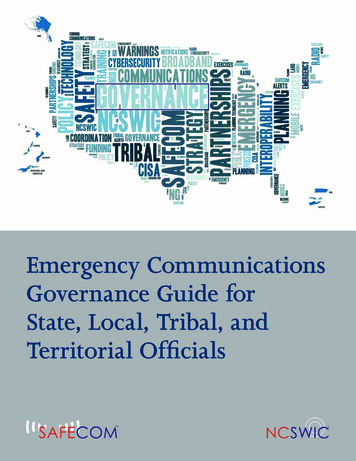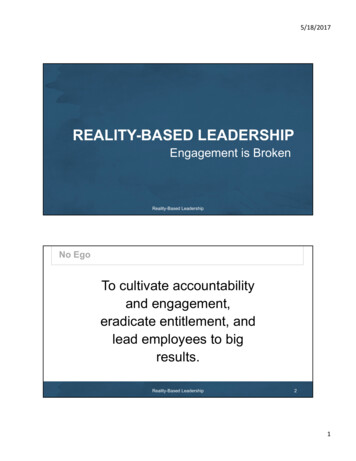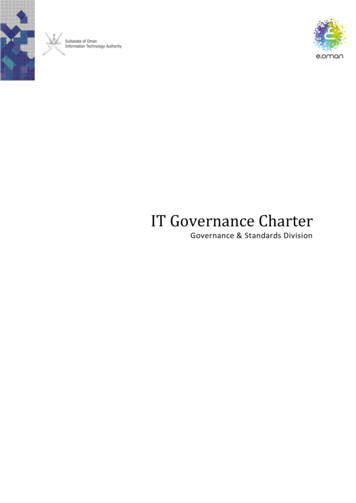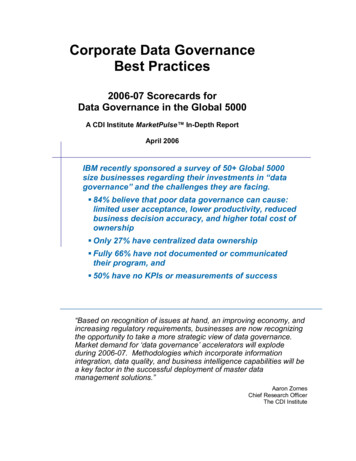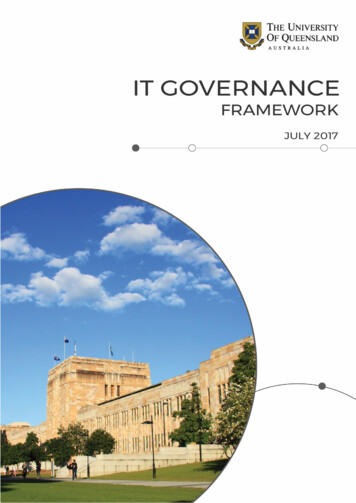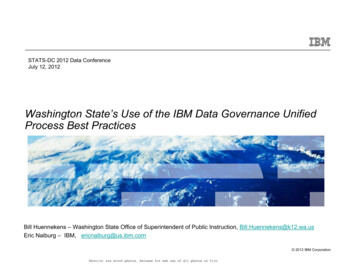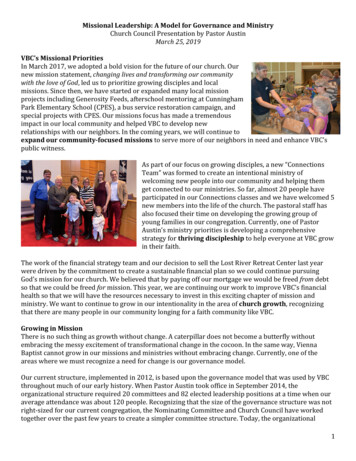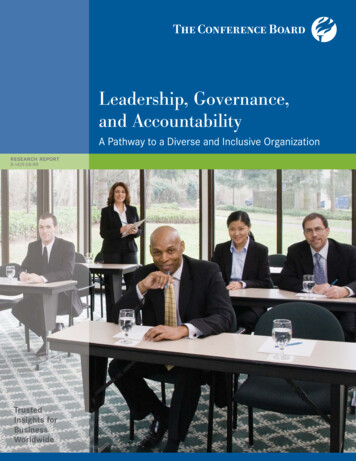
Transcription
Leadership, Governance,and AccountabilityA Pathway to a Diverse and Inclusive Organizationresearch reportR-1429-08-RRTrustedInsights forBusinessWorldwide
The Conference Board MissionThe Conference Board creates and disseminates knowledge aboutmanagement and the marketplace to help businesses strengthen theirperformance and better serve society.Working as a global, independent membership organization in the publicinterest, we conduct research, convene conferences, make forecasts,assess trends, publish information and analysis, and bring executivestogether to learn from one another.The Conference Board is a not-for-profit organization and holds501 (c) (3) tax-exempt status in the United States.Trusted Insights for Business WorldwideDrawing on both our own economic and management expertise and the hardwon insights and wisdom of our members, The Conference Board offers aunique forum for addressing today’s most pressing business issues. Our crossfunctional approach and global reach provide our network of leading executiveswith an enterprise-wide perspective on the challenges they face in theirorganizations, their markets, and their communities.Leadership & StrategyGovernance & EthicsCitizenship & SustainabilityEconomics & FinanceHuman Resources, TalentManagement & DiversityOperations & Business ProcessesMarketing & CommunicationsFor more information visit www.conference-board.org
Leadership, Governance, and AccountabilityA Pathway to a Diverse and Inclusive Organizationby Stephanie J. CrearyContents4Glossary of Terms5Introduction5Where We Have Been8Where We Are Headed10Leadership10Start at the Top: Articulate the Vision13Governance and Accountability13Establish Goals, Objectives, and Strategies15Design and Implement Systems22Seek Continuous Improvement22Planning for the Future: Sustaining Diversity and Driving Sustainable Change
4Le a d e r s h i p , G o v e r n a n c e , a n d A c c o u n t a b i l i t y : A Pa t h w a y to a D i v e r s e a n d I n c l u s i v e O r g a n i z a t i o nT h e C o n fe r e n c e B o a r dGlossary of TermsDiversity has moved from an initiative-driven practice to one that ismore strategic. Using business language accurately to describe diversityprinciples has become critical to establishing clear communication.There are vast differences in how the following words have been usedin the literature, so it is first important to clarify how several keybusiness terms will be used in the context of this report:Goals Targeted outcomes at the organizational levelExample Increase revenue by 10 percentObjectives A goal that is much narrower but is generallyused interchangeably with “goals”Example Develop products targeted to younger generationsStrategy Management’s action plan for how to achieve goalsand/or objectivesExample Create a balanced and representative workforceInitiatives Tactically focused programs designed to raiseawareness and improve competencyExample Create a college recruiting programActivities Tactically focused actions that are necessaryas part of any initiative or programExample Distribute surveys to prospective applicants at career fairsExample Seek prospective applicant feedback on the interview process
Le a d e r s h i p , G o v e r n a n c e , a n d A c c o u n t a b i l i t y : A Pa t h w a y to a D i v e r s e a n d I n c l u s i v e O r g a n i z a t i o nT h e C o n fe r e n c e B o a r dIntroductionWhere We Have BeenDynamic companies have embodied it, great leaders have espoused it, and mathematicalmodeling now appears to prove it: diversity offers competitive advantage. In the words ofeconomist and mathematical modeler Scott E. Page, “Diverse groups of people bring toorganizations more and different ways of seeing a problem and, thus, faster/better ways ofsolving it.”1 Globalization and technological advances continue to speed the pace ofchange and increase the complexity of staying competitive. Making strategic and operational mistakes can be more costly in this kind of environment. Diversity, accordingto Page, reduces both the chance of getting “stuck” and making errors in prediction. It’shard to imagine choosing homogeneity over inclusion and diversity.GM’s diversity logo is an illustration of some of the dimensions that compose one’s identity. Adapted from the Loden/Rosener model, the inner ring highlights the traditionaldimensions of difference, often described as either unchangeable or “endowed” by one’sExhibit sRaceEthnicityGenderFunctionalSpecialitybJo velLeReligiousBeliefslritaMa tusatSMExp ilitaryeriencen/Bor eivevNat n -NatiNongkiin lesTh StyUnNon ion/-Unionicaph nogrGe catioLo/ilym lifeFa orkWAgecatParentalStatusEconoStat micusNo Smon- keSm r/okerrkWo oundkgrBacCommunicationStyleDiversity wheelSource: General Motors, adapted from Marilyn Loden and Judy B. Rosener, Workforce America! Managing Employee Diversity as aVital Resource (New York: McGraw-Hill, 1991), p. 20.]1 Scott E. Page, “A Conversation with Scott E. Page: In Professor’s Model, Diversity Productivity,” NewYork Times, F2, January 8, 2008. See also, Scott E. Page, The Difference: How the Power of DiversityCreates Better Groups, Firms, Schools, and Societies (Princeton, N.J.: Princeton University Press, 2007).5
6Le a d e r s h i p , G o v e r n a n c e , a n d A c c o u n t a b i l i t y : A Pa t h w a y to a D i v e r s e a n d I n c l u s i v e O r g a n i z a t i o nT h e C o n fe r e n c e B o a r dbirth. The outer ring extends this concept to include the dimensions that relate to a person’s work and life choices. The logo and tagline “Many People, One GM, Now” are usedto brand GM’s diversity initiatives and show that GM aims to create a culture and a business environment based upon inclusion and understanding of all types of difference.Based on past diversity practices, some leaders have assumed that diversity is solely aboutincreasing racial, national, gender, or class representation among the employees to promote equal opportunity, and not so much about leveraging difference to enhance organizational effectiveness.2 David Thomas and Robin Ely propose that this perspective evolvedfrom the “discrimination-and-fairness” approach to diversity, which has focused on equaltreatment, recruitment of underrepresented groups, and compliance with federal laws. Theauthors argue that use of this paradigm “insist[s] that everyone is the same, but, with itsemphasis on equal treatment, puts pressure on employees to make sure that important differences among them do not count.”3 By creating practices that ignore differences, manyleaders have ceased to understand how diversity may improve business performance andas a result may have impeded the execution of diversity strategy.A seemingly stronger business case for diversity may be made using the “access-andlegitimacy” paradigm of the 1980s and 1990s. Under this model, companies celebratedifferences and seek to recruit employees that reflect their new markets in order to betterunderstand and serve customers. As part of a target marketing strategy, companies willhire members of underrepresented racial and ethnic groups to advertise products to andspecifically create products for those communities that will generate revenue for the company. But Thomas and Ely indicate that the weakness of this paradigm lies in the tendencyof companies to create teams that function as “little spin-off companies in their own right,doing their own exotic, slightly mysterious cultural-diversity thing in a niche market oftheir own.”4 Moreover, these practices “push staff with niche capabilities into differentiated pigeonholes without trying to understand what those capabilities really are and howthey could be integrated into the company’s mainstream work.”5Without attention to integration, the actions of employees hired to engage in target marketing are viewed as separate from the business, which may negatively impact their careerdevelopment and investment in the organization. As a result, those employees may feellimited in their potential for contributing to the overall business—not just a sector of it—and wind up leaving the company altogether.2 David Thomas and Robin Ely, “Making Difference Matter: A New Paradigm for Managing Diversity,”Harvard Business Review, Volume 74, Number 5 (September—October 1996) pp. 79—90.3 Ibid.4 Ibid.5 Ibid.
Le a d e r s h i p , G o v e r n a n c e , a n d A c c o u n t a b i l i t y : A Pa t h w a y to a D i v e r s e a n d I n c l u s i v e O r g a n i z a t i o nT h e C o n fe r e n c e B o a r dOrganizations that emphasize the understanding of diverse perspectives not only forthe sake of competitive advantage, but also for innovation—grow the entire organizationthrough the creation of ideas, products, and services. Sodexo’s model for diversity integration (Exhibit 2) illustrates components that are necessary for incorporating diversity intothe core of their business. The smaller circles are linked and connected with the largercircle as a means of highlighting this interdependency.6This critique of earlier approaches to diversity is not intended to suggest that businessesshould not continue to actively recruit members of underrepresented groups, comply withfederal laws, or have their workplaces reflect changing marketplaces. Instead, it indicateshow business improvement can be achieved if diversity and inclusion (D&I) are embodiedas central to the company’s development, manufacture, and sales of its product.When diversity is aligned with the business strategy, employees better understand theimportance of thinking differently to best respond to the needs of the organization and themarket. Companies can then “enhance work by rethinking primary tasks and redefiningmarkets, products, strategies, missions, business practices and even cultures” to tap intothe benefits of diversity.7Exhibit 2Sodexo’s model for diversity integrationRecognitionInternal &ExternalStrongSupplierDiversity &PartnershipCommitmentfrom theTopStrongBusinessCaseDiversityIntegratedinto Coreof culatedDiversityStrategyResources& StructureGrassRootsInvolvementSource: Sodexo6 Sodexo employs 342,000 employees in 80 countries, with its global headquarters in Paris. Its 2007revenues total 17.7 billon.7 David Thomas and Robin Ely, “Making Difference Matter: A New Paradigm for Managing Diversity,”Harvard Business Review, Volume 74, Number 5 (September-October 1996) pp. 79-90.7
8Le a d e r s h i p , G o v e r n a n c e , a n d A c c o u n t a b i l i t y : A Pa t h w a y to a D i v e r s e a n d I n c l u s i v e O r g a n i z a t i o nT h e C o n fe r e n c e B o a r dWhere We Are HeadedSuccessfully integrating change into any organization takes leadership, governance,accountability, and an iterative process of continuous improvement. The change requiredto build a diverse and inclusive organization is no different. Without incorporating thesecore principles, a diversity initiative will likely fall short.“IBM has long understood that an inclusive workplace is critical to ourability to attract the best people and maximize their ability to worktogether to create truly innovative products and services to meet theneeds of our clients. We believe our commitment to diversity is both amoral and a business imperative that will benefit our company’s bottomline as we compete in today’s increasingly global economy.”8Ron Glover Vice President, Global Employees Diversity, IBMSupported by these pillars, and reinforced by a commitment to secure continuousimprovement, organizations seeking to build a diverse and inclusive organization can utilize the following four steps, which will be discussed in detail throughout the remainder ofthis report:1234Start at the Top: Articulate the VisionEstablish Goals, Objectives, and StrategiesDesign and Implement SystemsSeek Continuous Improvement8 IBM employs 355,700 people globally, and its global headquarters is in Armonk, New York. IBM’s 2007revenues total 98.8 billion.
Le a d e r s h i p , G o v e r n a n c e , a n d A c c o u n t a b i l i t y : A Pa t h w a y to a D i v e r s e a n d I n c l u s i v e O r g a n i z a t i o nT h e C o n fe r e n c e B o a r dExhibit 3 illustrates how these four steps align with the required components forsuccessful change.Leadership at the top of the organization first articulates the vision, which drives thedesired change. Governance and accountability simultaneously work to ensure actionthrough the establishment of goals, objectives, and strategies, and the oversight ofsystems design and implementation. Continuous improvement creates a cycle oflearning and increased effectiveness over time.Exhibit 3Process of continuous improvementStart at the TopSeek ulate theVisionGovernanceDesign andImplement SystemsEstablish Goals,Objectives, andStrategiesKey ElementsLeadership The ability to influence, motivate, encourage, and enable others to contributetoward the effectiveness and success of an organizationGovernance The mechanisms and systems used to ensure that appropriate leaders areinvolved and established processes and policies are followedAccountability The acknowledgement and assumption of responsibility on the part ofvarious leaders for their roles in performance management and process improvement9
10Le a d e r s h i p , G o v e r n a n c e , a n d A c c o u n t a b i l i t y : A Pa t h w a y to a D i v e r s e a n d I n c l u s i v e O r g a n i z a t i o nT h e C o n fe r e n c e B o a r dLeadershipStart at the Top: Articulate the VisionEffective communication of leaders’ expectations throughout the organization is paramount. The most effective process for change starts at the top. By looking at the behaviorsencouraged (or discouraged) by top management, employees gain the greatest sense of thecompany’s commitment to any initiative.“Chevron operates in many countries around the world. I encourage all of usto behave in a manner consistent with the Chevron Way, which calls on usto trust, respect, and support each other and to embrace a diversity ofpeople, ideas, talents, and experiences. Diversity is a core value. I stronglybelieve that as we exhibit the inclusive behaviors for which we have cometo be known, we will strengthen our company and be a positive force in thecommunities in which we operate.”9David J. O’Reilly CEO, ChevronWithout clear communication flowing between leaders and employees, the importance ofhaving a diverse and inclusive environment will not be understood. Since implementing adiversity strategy entails change, good communication is necessary to both provide information to and encourage participation from all employees. It is up to senior management toclearly articulate the company’s values, goals, and strategic vision so that all employeesunderstand their roles in the execution process.As part of the communication strategy, top management articulates why the strategymakes good business sense, how it will move the company beyond where it is today, andhow it aligns with the company’s values. By giving employees reasons to believe in thestrategy, leaders increase the likelihood of winning support. Moreover, by involvingemployees in processes that help identify the need for improvement, employees canbecome encouraged to take actions that benefit the company.10 The most effectivecommunication strategies for diversity are informative yet inspirational, while reinforcingthe company’s commitment to diversity as a core value.9 Chevron’s global headquarters is in San Ramon, California, and it employs 62,000 people in 180countries. Chevron’s 2007 revenues total 214 billion.10 Ian Palmer, Richard Dunford, and Gib Akin, Managing Organizational Change: A Multiple PerspectivesApproach (New York: McGraw-Hill Irwin, 2006).
Le a d e r s h i p , G o v e r n a n c e , a n d A c c o u n t a b i l i t y : A Pa t h w a y to a D i v e r s e a n d I n c l u s i v e O r g a n i z a t i o nT h e C o n fe r e n c e B o a r dMichelin North America’s diversity policy is a good example:11Many different cultures, races, backgrounds, interests, and talents exist amongour employees and our communities. Michelin North America is committed tocreating an environment that respects these differences and recognizes thecompetitive advantage a diverse and cohesive workforce can achieve. Michelin North America is committed to actions that will bring increased fulfillment and cohesion to our employees, strength to our communities, and value toour shareholders and customers.Defining a strategic vision that is specific to the needs of the organization will effectivelysteer a company in a focused direction. Good vision statements are both descriptive andvisual, emphasizing the direction that an organization intends to take to enhance businessperformance. The most effective vision statements are also focused, flexible, feasible, andeasy to communicate. Today, companies’ visions for diversity address engaging diverse perspectives in order to foster innovation and creativity. Organizations that actively engagediverse perspectives to achieve desired business results are said to have “inclusive” cultures.GM’s pyramid is a good example of an image that a company may use to articulate thevision of diversity and guide its diversity and inclusion practices (Exhibit 4). At the baseof the pyramid is GM’s foundation—its consumers, dealers, employees, communities andExhibit 4GM diversity pyramidSource: General Motors11 Michelin North America’s headquarters is in Greenville, South Carolina; the Michelin Group isheadquartered in France. Michelin employs 22,000 people in the United States, Canada, and Mexico,and the Group employs 129,000 globally. Michelin Group’s 2007 revenues totaled 26.5 billion.11
12Le a d e r s h i p , G o v e r n a n c e , a n d A c c o u n t a b i l i t y : A Pa t h w a y to a D i v e r s e a n d I n c l u s i v e O r g a n i z a t i o nT h e C o n fe r e n c e B o a r dsuppliers. “Actions for leaders driving diversity,” “Guiding principles,” and “Vision” havespecifically been crafted as a means of considering how to best manage the differingneeds and expectations of these stakeholders as part of creating a more diverse and inclusive organization.Dialogue is essentialBuilding a diverse and inclusive organization entails making changes within the companythat may not be easily embraced. Seeking employee feedback from the onset of change isencouraged. Understanding employees’ needs helps identify how processes can beimproved. To introduce this, many leaders have created or sponsored employee dialoguegroups that allow employees to engage in concentrated conversations about diversity topics. Other ways to initiate a free-flow of communication within a company include: Create opportunities for feedback and value employees’ insight Disseminate employee opinion/attitude surveys and analyze data received Conduct formal and informal interviews that assess the work environment(i.e., cultural audits)If senior leaders engage in dialogues with employees and stakeholders, those conversations can reveal whether barriers to full employee contribution exist. For example, thefollowing conditions exist for many companies:Lack of opportunity In some cultures, there are not enough opportunities for employeesto develop their leadership skills and managerial potential. The problem could be augmented if the senior management ranks and board of directors do not reflect the demographics of the employees. As a result, employees perceive barriers to career advancementand are less invested in business performance.An exclusive company culture An exclusive culture does not engage and reward peoplewhose experiences, perspectives, or talents differ from the norm and may simultaneously encourage employees who conform to outdated standards. Exclusive norms caninclude limiting the amount of information that employees are given, ignoring or alienating those whose opinions differ, and not discouraging discriminating behavior. As a resultof exclusivity, employees limit their participation in idea generation and product development activities, as well as organizational change initiatives.It is through engaging in activities that seek employee input that many companies are ableto increase employees’ personal investment in the company. The company’s visionbecomes a shared one, which will inspire employees to contribute and sustain an increasein the level of employee participation in the future.
Le a d e r s h i p , G o v e r n a n c e , a n d A c c o u n t a b i l i t y : A Pa t h w a y to a D i v e r s e a n d I n c l u s i v e O r g a n i z a t i o nT h e C o n fe r e n c e B o a r dGovernance and AccountabilityEstablish Goals, Objectives, and StrategiesWhile articulating a vision sets the tone for what is expected for the future, the ultimatepurpose of setting goals and objectives is to convert top management’s vision into actionable performance targets. Goals should be measurable and include both long-term (in 3–5years) and short-term (quarterly or annually) timelines to most effectively drive participation.Diversity objectives ideally will be aligned with organizational goals and related toperformance improvement to generate maximum support. Today, the practice of diversityemphasizes having objectives (e.g., mirror the marketplace, seek full employee contribution, limit attrition, promote retention) and strategies for meeting those objectives(e.g., creating a balanced and representative staff; creating a fair, respectful, andinclusive culture).Diversity and Inclusion Success StoriesGeneral Motors’ Peoplewith Disabilities Group(GMPWD) has been a consistent resource for providing input and supportrelative to accessibility ofproducts and services forGM and for GM employees.They played a role in helping OnStar develop one oftheir latest innovations: theaddition of TTY capability,text telephone for the hearing impaired, for OnStarequipped vehicles. The GMPWD group meets with thesenior executive leadershipliaison to provide a voice tothe disabled communityand marketplace, and theirexpertise and experiencehelps GM provide theresources and accommodations for employees andcustomers to ensureemployee success andcustomer enthusiasm.IBM created the MarketDevelopment organization toassist businesses owned byAsians, African-Americans,Hispanics, Native Americans,and women. Its charge wasto develop and implement astrategy designed to increasethese businesses’ “mindshare” and “market share”and to market IBM’s portfolioof business solutions. As aresult of these efforts, theMarket Development organization has contributed considerable revenue to IBM forseveral years.PepsiCo’s Adelante, its Hispanic employee network, provided insights that resulted in the development of the guacamole chip. In the first full yearof distribution, PepsiCo’s Frito-Lay division sold 100 million in Lay’s guacamole chips. But thenetwork’s impact goes beyond revenue. EnAble,another of the networks, created an ad to airduring the Super Bowl pre-game show. Dedicatedto advancing people with different abilities, theEnAble group’s ad provided consumers withglimpses into the reality of being “differently abled”and into the culture of PepsiCo networks. Theresponse to the spot — filmed entirely in AmericanSign Language — was overwhelming. Nearly850,000 views on video-sharing sites were generated before the ad aired. After airing, it elicited ahost of “thank you” videos on YouTube by the deafcommunity and mentions in more than 3,000blogs. Maurice Cox, vice president of corporatedevelopment and diversity, explained: “Our employeenetworks support our incredibly diverse employeebase — but more important, they have played acritical role in growth and development. Today, ourassociates who are active in networks have a voicethat is heard throughout the company, influencingproduct innovation, marketing, and sales, as well ascommunity response and outreach.”Source: General MotorsSource: David A. Thomas, “Diversityas Strategy,” Harvard BusinessReview, Volume 82, Issue 9,September 2004, pp. 1-11.Source: PepsiCo13
14Le a d e r s h i p , G o v e r n a n c e , a n d A c c o u n t a b i l i t y : A Pa t h w a y to a D i v e r s e a n d I n c l u s i v e O r g a n i z a t i o nT h e C o n fe r e n c e B o a r dProcess of linking diversity to business practicesThe goals, objectives, and strategies outlined below are presented as ways to link diversitystrategies and business goals. They are not necessarily concrete “steps” to reaching goals,but merely ideas and options for addressing them.Sample 1Goal: To increase revenue by percentObjective: To develop # new and innovative products for X and Y market segmentsDiversity Strategy 1: Create a balanced and representative group of employeesthat mirrors the marketplaceDiversity Strategy 2: Create a fair, respectful, and inclusive culture that seeks fullemployee contributionSample 2Goal: To improve operational efficiency and cut costs by percentObjective: To reduce attrition rates for X employee groups to percentDiversity Strategy 1: Create a representative and balanced group of employeesthat mirrors the marketplaceDiversity Strategy 2: Create representative and balanced teams internally thatmirror the company’s workforceDiversity Strategy 3: Seek parity in pay and promotionsDiversity Strategy 4: Create a fair, respectful, and inclusive culture that seeks fullemployee contributionReal-World Example of Goal-SettingAs part of Pitney Bowes’s annual Diversity Strategic Planning process, managers andexecutives consider how objectives can be tailored to address diversity in the marketplace.They take the following questions into consideration: What must you do the same or differently with your current/future products given changesin the demographics of customers/end user? Who is your end user?How is the profile of that person changing?What are the demographic implications of your current markets?Where are the opportunities for future markets?How can you leverage the diversity of your people to look at your products and marketopportunities differently?Source: Pitney Bowes
Le a d e r s h i p , G o v e r n a n c e , a n d A c c o u n t a b i l i t y : A Pa t h w a y to a D i v e r s e a n d I n c l u s i v e O r g a n i z a t i o nT h e C o n fe r e n c e B o a r dDesign and Implement SystemsBy this point, senior management has created an environment that encourages employeesto actively contribute their ideas. This has helped the leadership team determine the direction diversity initiatives will take in the organization. Goals and objectives have been created to convert the vision of diversity and inclusion into measurable performance targets.The process thus far has focused on inspiring and motivating employees to contribute tothe success of the organization, but also included leaders’ clearly defined expectations thatare understood by employees. From this point forward, the process concentrates on creating and executing strategies that indicate prime areas for improvement.Implementing strategy is a time-consuming process and requires important competenciesand expertise in order to convert strategic plans into actions. Exhibit 5 illustrates the competencies required for executing diversity strategy.Exhibit 5Competencies for converting strategic plans into actionsCompetenciesActionsIdentification Ability to recognize needs and a willingnessto fulfill them, such as allocating proper human and financialresources to achieve program goalsAssign roles and responsibilities and implement a budgeting systemAppoint a highly knowledgeable and skilled diversity practitioner to oversee programsCommunication Ability to understand the content of whathas been said and the meaning it holds, and the abilityto reflect this back to the speakerElaborate and incorporate ideas from multiple sources by engaging indiscussions that explore diverse ways to address problems and opportunitiesCollaboration Look outward for fresh ideasInstall information and operating systems that enable employees to carry out their rolesEnlist others in the processImplement decisions that have been agreed to by the teamForm cross-functional teams consisting of employees from different backgroundsand levels of experienceCommitment and Integrity Holding others accountablefor making choices that are consistent with team andorganizational valuesCreate and implement scorecards and performance management tools thatassess progress on an ongoing basisCreating incentive programs that include bonus compensation and recognitionIncludes text from: Ruth Wageman et al., Senior Leadership Teams: What It Takes to Make Them Great (Boston: Harvard Business School Press, 2008).15
16Le a d e r s h i p , G o v e r n a n c e , a n d A c c o u n t a b i l i t y : A Pa t h w a y to a D i v e r s e a n d I n c l u s i v e O r g a n i z a t i o nT h e C o n fe r e n c e B o a r d“To truly achieve cultural diversity, everyone must be responsibleand ‘own’ it. Every employee can make a difference becauseeach of us shapes our culture and builds the future,moment by moment, interaction by interaction.”Carole Young General Manager of Global Diversity, ChevronBut change cannot take hold without commitment. The following points highlight howaccountability can further support organizational change: Outline roles and responsibilities within a clear reporting structure Measure and reward performance Ensure effectiveness of the initiativesOutline roles and responsibilities within a clear reporting structureFor companies to successfully execute any strategy, accountability—the acknowledgementof roles and assumption of responsibility by employees—must be integrated into theprocess. Leaders not only emphasize that achieving organizational goals is part of everyemployee’s j
The Conference Board is a not-for-profit organization and holds 501(c) (3) tax-exempt status in the United States. Trusted Insights for Business Worldwide Drawing on both our own economic and management expertise and the hard-won insights and wisdom of ou

